
A deer or true deer is a hoofed ruminant ungulate of the family Cervidae. It is divided into subfamilies Cervinae and Capreolinae. Male deer of almost all species, as well as female reindeer, grow and shed new antlers each year. These antlers are bony extensions of the skull and are often used for combat between males.

The Père David's deer, also known as the milu or elaphure, is a species of deer native to the subtropical river valleys of China. It grazes mainly on grass and aquatic plants. It is the only extant member of the genus Elaphurus. Some experts suggest demoting Elaphurus to a subgenus of Cervus. Based on genetic comparisons, Père David's deer is closely related to Eld's deer.

The sika deer, also known as the Northernspotted deer or the Japanese deer, is a species of deer native to much of East Asia and introduced to other parts of the world. Previously found from northern Vietnam in the south to the Russian Far East in the north, it is an uncommon species that has been extirpated in most areas of its native range, except in Japan, where it is overabundant and present in very large numbers.
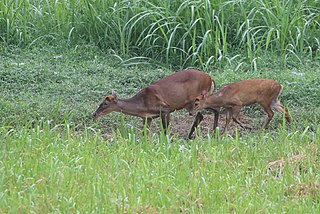
Muntjacs, also known as the barking deer or rib-faced deer, are small deer of the genus Muntiacus native to South Asia and Southeast Asia. Muntjacs are thought to have begun appearing 15–35 million years ago, with remains found in Miocene deposits in France, Germany and Poland. Most are listed as least-concern species or Data Deficient by the International Union for Conservation of Nature (IUCN), although others such as the black muntjac, Bornean yellow muntjac, and giant muntjac are vulnerable, near threatened, and Critically Endangered, respectively.
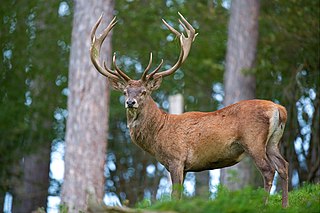
The red deer is one of the largest deer species. A male red deer is called a stag or hart, and a female is called a doe or hind. The red deer inhabits most of Europe, the Caucasus Mountains region, Anatolia, Iran, and parts of western Asia. It also inhabits the Atlas Mountains of Northern Africa; being the only living species of deer to inhabit Africa. Red deer have been introduced to other areas, including Australia, New Zealand, the United States, Canada, Peru, Uruguay, Chile and Argentina. In many parts of the world, the meat (venison) from red deer is used as a food source.

The chital or cheetal, also known as the spotted deer, chital deer and axis deer, is a deer species native to the Indian subcontinent. It was first described and given a binomial name by German naturalist Johann Christian Polycarp Erxleben in 1777. A moderate-sized deer, male chital reach 90 cm (35 in) and females 70 cm (28 in) at the shoulder. While males weigh 70–90 kg (150–200 lb), females weigh around 40–60 kg (88–132 lb). It is sexually dimorphic; males are larger than females, and antlers are present only on males. The upper parts are golden to rufous, completely covered in white spots. The abdomen, rump, throat, insides of legs, ears, and tail are all white. The antlers, three-pronged, are nearly 1 m long.
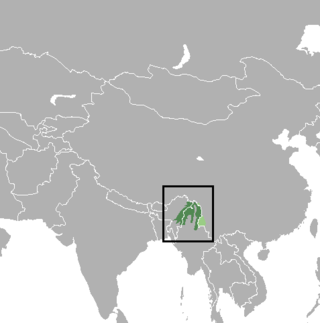
The leaf muntjac, leaf deer or Putao muntjac is a small species of muntjac. It was documented in 1997 by biologist Alan Rabinowitz during his field study in the isolated Nogmung Township in Myanmar. Rabinowitz discovered the species by examining the small carcass of a deer that he initially believed was the juvenile of another species; however, it proved to be the carcass of an adult female. He managed to obtain specimens, from which DNA analysis revealed a new cervid species. Local hunters knew of the species and called it the leaf deer because its body could be completely wrapped by a single large leaf. It is found in Myanmar and India.

The southern red muntjac is a deer species native to Southeast Asia. It was formerly known as the Indian muntjac or the common muntjac before the species was taxonomically revised to represent only populations of Sunda and perhaps Malaysia. The other populations being attributed to this species are now attributed to Muntiacus vaginalis. Muntjacs are also referred to as barking deer. It is listed as Least Concern on the IUCN Red List.

The water deer is a small deer species native to Korea and China. Its prominent tusks, similar to those of musk deer, have led to both subspecies being colloquially named vampire deer in English-speaking areas to which they have been imported. It was first described to the Western world by Robert Swinhoe in 1870.

The tufted deer is a small species of deer characterized by a prominent tuft of black hair on its forehead and fang-like canines for the males. It is a close relative of the muntjac, living somewhat further north over a wide area of central China and northeastern Myanmar. Suffering from overhunting and habitat loss, this deer is considered near-threatened. It is the only member of the genus Elaphodus.
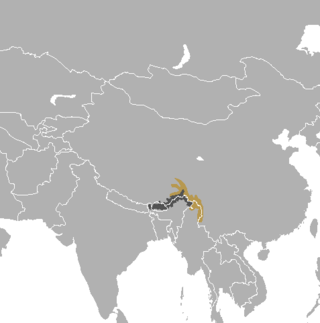
The Gongshan muntjac is a species of muntjac living in the Gongshan mountains in northwestern Yunnan, southeast Tibet, Northeast India and northern Myanmar.

Thorold's deer is a threatened species of deer found in grassland, shrubland, and forest at high altitudes in the eastern Tibetan Plateau. It is also known as the white-lipped deer for the white patches around its muzzle.
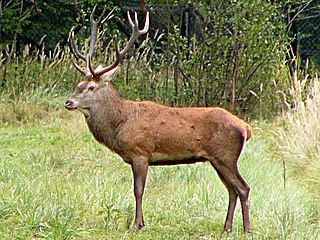
Cervus is a genus of deer that primarily are native to Eurasia, although one species occurs in northern Africa and another in North America. In addition to the species presently placed in this genus, it has included a whole range of other species now commonly placed in other genera. Additionally, the species-level taxonomy is in a state of flux.
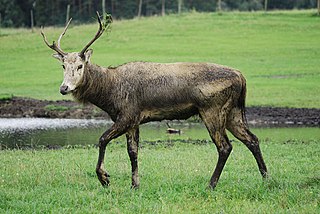
The Cervinae or the Old World deer, are a subfamily of deer. Alternatively, they are known as the plesiometacarpal deer, due to having lost the parts of the second and fifth metacarpal bones closest to the foot, distinct from the telemetacarpal deer of the Capreolinae.
An ornamental animal is an animal kept for display or curiosity, often in a park. A wide range of mammals, birds and fish have been kept as ornamental animals. Ornamental animals have often formed the basis of introduced populations, sometimes with negative ecological effects, but a history of being kept as ornamental animals has also preserved breeds, types and even species which have become rare or extinct elsewhere.

The preorbital gland is a paired exocrine gland found in many species of artiodactyls, which is homologous to the lacrimal gland found in humans. These glands are trenchlike slits of dark blue to black, nearly bare skin extending from the medial canthus of each eye. They are lined by a combination of sebaceous and sudoriferous glands, and they produce secretions which contain pheromones and other semiochemical compounds. Ungulates frequently deposit these secretions on twigs and grass as a means of communication with other animals.
Clapgate Pits is a disused quarry near Broughton, Lincolnshire. This 1.0 ha site has been managed by Lincolnshire Wildlife Trust since 1996. It provides an environment for several plants which are rare in Lincolnshire: pale St John's-Wort, Squinancywort and Wall Germander. Until 1969 it was the most northerly site in Britain for Pasqueflower but these plants were apparently dug up by vandals.

















